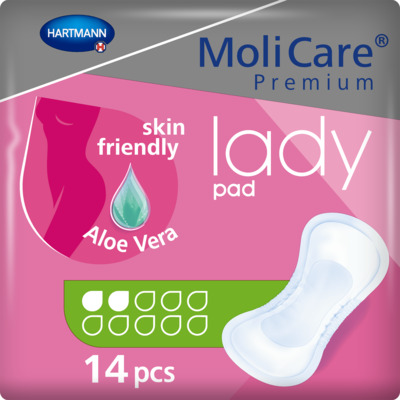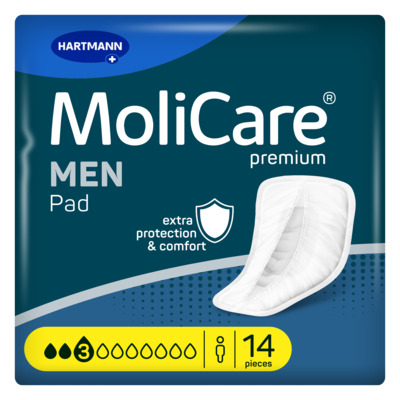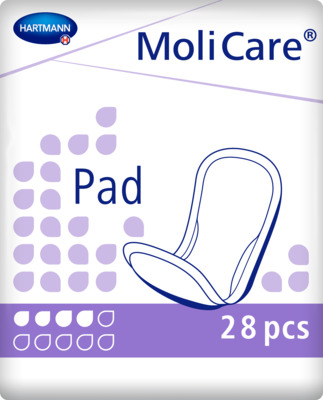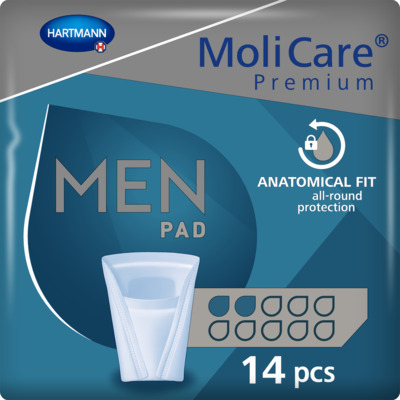Incontinence Advice
Incontinence in the Workplace: 10 Tips for Effective Management
Navigating the workplace with incontinence can be challenging. However, with the right strategies and understanding, it's possible to still be productive without having to worry about possible leakages… In various work environments – whether an office, factory, or shop floor – it is not always easy to reach the toilet on time, especially when managing incontinence. This article will explore how to handle incontinence at work, offering tips for both men and women on how to manage the condition effectively. Key points: Understand different types of urinary incontinence to identify which type you may be experiencing. Discover protective incontinence products that offer both comfort and discretion in the workplace. Learn how to approach your incontinence needs with your employer. Look into workplace adjustments such as flexible schedules and strategic breaks. Review tips for managing symptoms effectively at work, including hydration and exercise routines.

Understanding types of incontinence
Managing incontinence starts with recognising the symptoms.
Many people may not realise that what they are experiencing is actually a form of urinary incontinence (UI).
There are several types of UI:
Stress incontinence: This occurs when physical movements like coughing, sneezing, or lifting heavy objects cause urine leakage.
Urge incontinence: This is recognised as a sudden, intense urge to urinate, followed by involuntary leakage. This can be disruptive if you feel the need to visit the toilet frequently throughout the working day (up to 8 times or more).
Overflow incontinence: This involves continuous dribbling due to incomplete bladder emptying.
Functional incontinence: This is when incontinence occurs due to difficulty reaching the toilet in time, which can be due to mobility or disability issues.
Mixed Incontinence: This is a combination of symptoms from more than one type of urinary incontinence. On average, at least 50% of people with stress incontinence will also have urge incontinence, leading to mixed incontinence.
Understanding these types can help you better manage your condition and discuss appropriate accommodations with your employer.
Why employers should accommodate for incontinence in the workplace
Incontinence in the workplace is not just a personal issue – it’s a workplace issue that deserves attention. Here are three reasons why your employer should accommodate this condition:
Prevalence: You are not alone; many people silently manage these symptoms.
Uncontrollability: Incontinence is not a condition that an individual can control. It can be embarrassing and difficult to deal with in the workplace.
Right to support: Everyone deserves a supportive and inclusive work environment where they can manage their health needs without stigma.
Impact of urinary incontinence on job performance
Incontinence in the workplace can significantly affect various aspects of a person’s professional life. Studies show employees with urinary incontinence (UI) experience difficulties such as:
Concentration: Frequent urination and other toiletry breaks can distract from work tasks.
Physical activities: UI can be particularly challenging in roles requiring physical exertion, such as lifting or bending, which might trigger leakage.
Self-confidence: Worrying about potential accidents can reduce an employee’s self-esteem and workplace engagement.
These challenges underscore the need for understanding and accommodations in work settings to support employees managing UI.
Problems with urinary incontinence in the workplace
Trying to manage incontinence in the workplace discretely can lead to workplace dilemmas such as:
Increased toilet breaks: Frequent trips to the toilet may become necessary if you are experiencing incontinence at work. This could be embarrassing and logistically challenging, especially in a busy work environment. However, it is important to go to the toilet when you need to, as holding on to urine or not changing a pad for many hours at a time can potentially lead to health complications such as urinary tract infections.
Reluctance to discuss openly: Stigma surrounding incontinence can make employees hesitant to discuss their incontinence with supervisors or colleagues, with only 12% feeling comfortable doing so. This silence can prevent the implementation of necessary support structures in the workplace.

10 tips on managing incontinence in the workplace
Discussing your incontinence needs with your employer can have several benefits, not just for yourself but for other colleagues as well. Here are some effective management tips:
Timed toilet breaks
Schedule regular toilet breaks to reduce the risk of accidents and maintain control. Creating a routine can help to accommodate your needs with minimal disruption to the workday.
Physical exercise
Remaining active is important, especially for people with desk jobs. Engaging in low-impact exercises such as Pilates or yoga can strengthen the pelvic floor muscles, which can lead to increased bladder control. Integrating these activities into your daily routine, either before or after work, or during breaks, can improve overall bladder function and reduce symptoms.
Bladder diary
Keeping a bladder diary is an effective way to monitor and understand your incontinence symptoms and triggers. This diary could log information such as how many times a day you wee, the volume of urine passed, whether you were able to hold on to the urine or not, how many pads you required, and any relevant food or drink intake.
Sharing this information with a healthcare provider can help tailor a more effective management plan.
Wear comfortable clothes
Dressing comfortably can make managing incontinence at work less stressful. For those who work in an office environment that allows for smart casual clothes, this should be easily adjustable. If you're unsure about the best options, consider consulting an occupational health therapist. Remember, the goal is to maintain both comfort and professionalism without compromising on your comfort and well-being.
Flexible working
Discuss flexible working options, such as hybrid working, with your employer to find a mutually agreeable solution that supports your needs while maintaining productivity.
Pelvic floor exercises
Regular pelvic floor exercises can greatly improve bladder control. These exercises can be done discreetly at your desk and are effective in strengthening the muscles that help manage incontinence.
Hydration and diet
Be sure to drink between 6-8 glasses of water a day to balance your fluid intake and consider these bladder cleansing foods.
Avoid foods and drinks that irritate the bladder, such as caffeine, and opt for water or herbal teas instead. Additionally, maintaining a diet rich in fibre can prevent constipation. The following easy-to-eat snacks, can ease this too:
Avocado
Bananas
Pears
Raspberries
Strawberries
Desk position
Requesting a workstation close to the toilet can minimise stress and make it easier to manage frequent toilet trips. Ensure that you are sitting correctly at your desk too, as this simple adjustment can be a significant relief for those with stress incontinence.
Spare clothes
Always have spare clothing and extra incontinence products at work to handle any unexpected leaks. Being prepared reduces anxiety and ensures that you can address issues quickly and discreetly with minimal disruption to your day.
Encouraging workplace support
Creating an environment where employees feel comfortable discussing and managing incontinence is beneficial for both the individual and the organisation.
Employers should encourage open dialogue, provide education about UI, and consider workplace modifications like accessible toilets and flexible break times to accommodate employees discreetly and respectfully. Alternatively, you can seek support from a colleague so that they are aware that you are actively trying to improve your incontinence and toiletry needs.
Choosing the right incontinence products with HARTMANN Direct
Selecting appropriate incontinence pads is crucial for managing UI effectively at work. Products designed to be discreet and comfortable can help maintain professionalism and confidence throughout the workday.
Features to look for include:
Comfort and fit: Products should fit well under work attire, offering protection without bulkiness.
Odour control: Effective odour control is essential for maintaining discretion.
Absorbency: Choose products based on your individual needs for absorbency.
All our products meet these criteria and can significantly help you to manage the impact of UI on your working life. Shop online and contact us today to find the best products for your needs.
Further reading:
Based on discussed topics within this article, here is some additional reading to elevate your control of incontinence:
Urine leakage when coughing - learn why this is a common issue.
Is incontinence a disability - find out if you are eligible for benefits.
Benefits of yoga - understand how yoga can help with incontinence.

FAQs
Should I inform my employer about my incontinence issues?
While it's a personal decision, informing your employer can help ensure you receive appropriate support and accommodations, such as flexible breaks or access to a toilet.
How can I discreetly manage incontinence at work?
Wear discreet incontinence pads or underwear, carry spare clothing, and use odour-neutralising products. Plan for quick and easy access to toilets.
Sources
Benefiber. (2020) Top 10 High-Fiber Foods. [online] Available at: https://www.benefiber.com/fiber-in-your-life/daily-fiber-intake/top-10-high-fiber-foods/ [accessed 04/09/24]
McQuilkie, S., DC, (2023) Proper Sitting Posture At A Desk – 10 Tips. Back Intelligence. [online] Available at: https://backintelligence.com/proper-sitting-posture-at-a-desk/ [accessed 04/09/24]

MoliCare® Premium Lady Pad 2 Drops
<h2>Skin Friendly Pant Liners</h2> <p>For women that experience slight incontinence and bladder weakness, across different age groups, it can be a challenge to find the right bladder weakness product that is easy to apply and wear without the worry of potential leakages. Fortunately, we understand this approach, hence why we are happy to offer our MoliCare® Premium Lady Pad 2 drops, that is skin-friendly, Aloe Vera applied, and comes with 14 liners per bag.</p> <h2>Slim and discreet liners</h2> <p>Whether dealing with stress incontinence or urge incontinence, these panty liners offer a discreet and easy solution on the go. Simply place the pad in your underwear and secure it with the adhesive strip for all-round protection. Available in different absorbency levels, MoliCare® bladder weakness products cater to all levels of bladder weakness, ensuring secure care.</p> <h2>Control Bladder Weakness</h2> <p>Enjoy the benefits of these body-shaped absorbent panty liners, designed for women with bladder weakness. The pads offer discreet, reliable protection with features including odour control and fast absorption.</p> <p>With a wide adhesive strip, you can comfortably fix the pad in your regular underwear, providing secure and comfortable fixation. The pads are skin-friendly, featuring soft, breathable materials, including foam cuffs, and a top sheet treated with Aloe Vera.</p> <p>Keeping your skin healthy is a priority, which is why MoliCare® Premium Lady Pads have a skin-neutral pH value of 5.5 and an antibacterial finish. They are also dermatologically tested, offering peace of mind.</p> <h2>Buy pant liners online</h2> <p>Never worry about running out with our convenient order service and fast delivery direct to your door. Enjoy free shipping on orders over £50.</p> <p>If you need assistance, our professional customer service team is here to support you in choosing the right product. Reach out to us today at 0800 028 9470 and experience the comfort and reliability of MoliCare® Premium Lady Pads.</p>
MoliCare® Premium Men Pad 3 Drops (ISO 441ml)
<p><strong>Reliable and discreet incontinence pads for men with an instant-dry feeling</strong></p> <p>Bladder weakness is difficult to live with, the last thing you want to worry about is incontinence protection. That’s why our best-ever MoliCare® premium MEN Pad 3 drops offer an <strong>all-round protection</strong> that keeps everything dry and comfortably in place while fitting discreetly in your regular underwear.</p> <p>The incontinence pad for men quickly <strong>removes urine from the surface up to 86 %* faster than before</strong> and neutralises unpleasant odours to leave you feeling instantly dry and in control thanks to the new <strong>MoliCare SkinGuard</strong>®<strong> Absorbent Core Technology</strong>. This skin-friendly technology not only helps you feel up to 90 %* drier than previous MoliCare® premium<strong> </strong>MEN pads, it also helps to maintain healthy skin and preventing irritation.</p> <p><strong>Engineered for the male anatomy</strong> and dermatologically tested for maximum skin compatibility, these male urinary pads do not contain colour, perfume or latex making them environmentally friendly too.</p> <p>*Compared to last generation</p>
MoliCare® Pad 4 Drops
<h2>Handy MoliCare incontinence pads to carry on the go</h2> <p>Our MoliCare® Pad 4 Drops are an essential product for those experiencing slight incontinence, allowing you to regain control and live your busy and active life without the interference of bladder weakness. Designed for both men and women, this incontinence pad for men and women offers exceptional dryness and protection, ensuring your comfort and confidence.</p> <h2>‘Barely There’ Reassurance and Reliability</h2> <p>The MoliCare® Pad 4 Drops are slimline, discreet, and adjusted to fit your body seamlessly. It fixes securely inside your underwear, providing a ‘barely there’ comfort feel. With its soft and skin-kind fabric, along with a wide adhesive fixing strip on the backsheet, you can go about your day with the assurance of being protected against leakages.</p> <p>The absorbent core effectively prevents your skin from becoming too moist, while the elastic anti-leak edging adds an extra layer of security and peace of mind. Say goodbye to any worries about odours, as the MoliCare® Pad 4 Drops also neutralises odours to keep you fresh and confident throughout the day. Don't let incontinence hold you back from living life to the fullest.</p> <p>Ordering your MoliCare® Pad 4 Drops is hassle-free, as we offer fast delivery direct to your door. With our price match promise, you can trust that you're getting the best value for your money. Plus, enjoy free delivery on all orders over £50.</p> <p>If you need assistance in finding the perfect incontinence product for your needs, our friendly customer care team is here to help. Don't hesitate to reach out to us at 0800 028 9470. Take control of your life with the reliable protection and comfort of the MoliCare® Pad, alongside other <a href="https://www.hartmanndirect.co.uk/incontinence-products/incontinence-pads" style="color:#0563c1; text-decoration:underline">incontinence pads</a>.</p>
